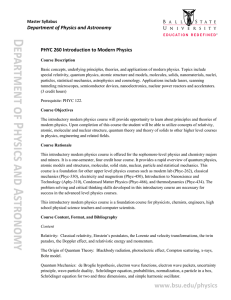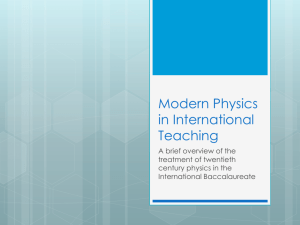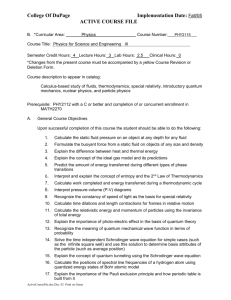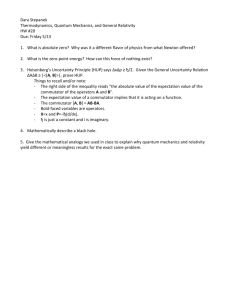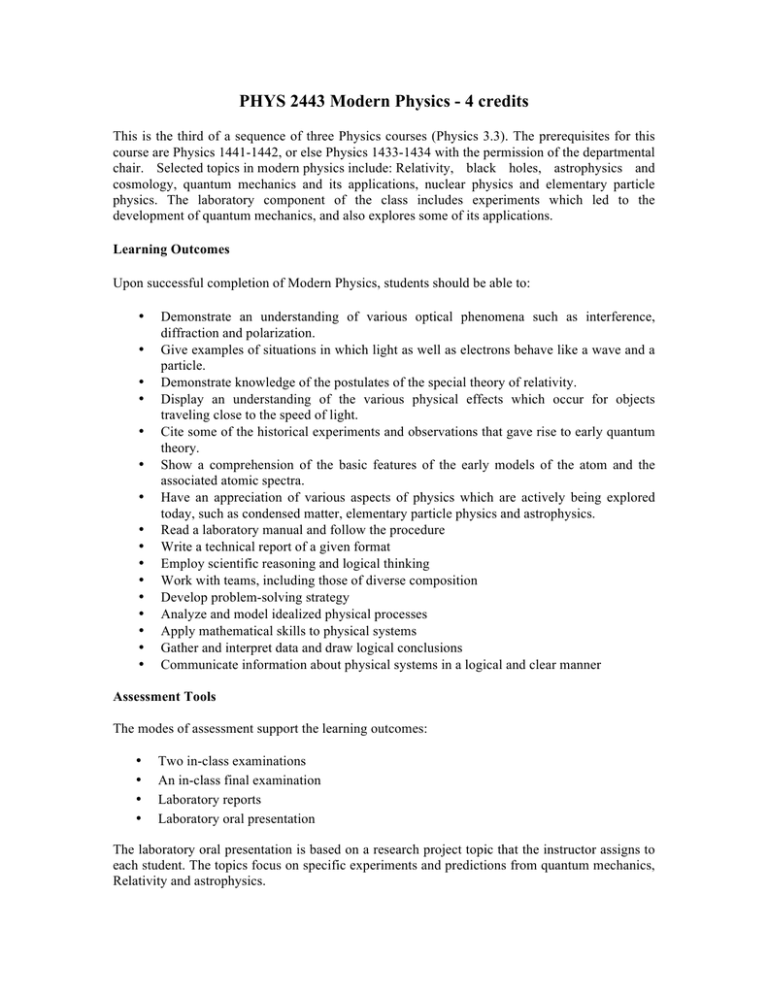
PHYS 2443 Modern Physics - 4 credits
This is the third of a sequence of three Physics courses (Physics 3.3). The prerequisites for this
course are Physics 1441-1442, or else Physics 1433-1434 with the permission of the departmental
chair. Selected topics in modern physics include: Relativity, black holes, astrophysics and
cosmology, quantum mechanics and its applications, nuclear physics and elementary particle
physics. The laboratory component of the class includes experiments which led to the
development of quantum mechanics, and also explores some of its applications.
Learning Outcomes
Upon successful completion of Modern Physics, students should be able to:
•
•
•
•
•
•
•
•
•
•
•
•
•
•
•
•
Demonstrate an understanding of various optical phenomena such as interference,
diffraction and polarization.
Give examples of situations in which light as well as electrons behave like a wave and a
particle.
Demonstrate knowledge of the postulates of the special theory of relativity.
Display an understanding of the various physical effects which occur for objects
traveling close to the speed of light.
Cite some of the historical experiments and observations that gave rise to early quantum
theory.
Show a comprehension of the basic features of the early models of the atom and the
associated atomic spectra.
Have an appreciation of various aspects of physics which are actively being explored
today, such as condensed matter, elementary particle physics and astrophysics.
Read a laboratory manual and follow the procedure
Write a technical report of a given format
Employ scientific reasoning and logical thinking
Work with teams, including those of diverse composition
Develop problem-solving strategy
Analyze and model idealized physical processes
Apply mathematical skills to physical systems
Gather and interpret data and draw logical conclusions
Communicate information about physical systems in a logical and clear manner
Assessment Tools
The modes of assessment support the learning outcomes:
•
•
•
•
Two in-class examinations
An in-class final examination
Laboratory reports
Laboratory oral presentation
The laboratory oral presentation is based on a research project topic that the instructor assigns to
each student. The topics focus on specific experiments and predictions from quantum mechanics,
Relativity and astrophysics.
Grading
The final grade is based on the following:
•
•
•
•
Average of two 1 hour and 40 min. examinations
Laboratory Grade
Research project
Final examination
= 40%
= 25%
= 10%
= 25%
Laboratory
This course is based on doing computer-based experiments in physics and traditional
experiments. Although the experiments are done in-group, each student must write and type his
own individual laboratory report. It consists of a title page, data sheet, computations, graphs,
discussions and questions.
Textbooks
• Physics for Scientists & Engineers with Modern Physics, Volume III
by Giancoli, 4th Edition. Pearson- Prentice Hall.
• Departmental handout materials
• Departmental handouts for Laboratory experiments
Topics
Week
1
2
3
Topic & Chapter
Chapter
Special Theory of Relativity
a. Galilean – Newtonian Relativity & speed of light
36
b. Postulates of the Special Theory of Relativity
c. Time Dilation and Length Contraction
Special Theory of Relativity
a. Lorentz Transformations
b. Relativistic Momentum and Mass
36
c. E = mc2; Mass and Energy
d. Doppler Shift for Light
Astrophysics and Cosmology
a. Stars and Galaxies
b. Stellar Evolution: Nucleosynthesis, and the Birth and
44
Death of Stars
c. Distance Measurements
d. General Relativity: Gravity and the Curvature of Space
Astrophysics and Cosmology
a. The Expanding Universe: Redshift and Hubble’s Law
b. The Big Bang and the Cosmic Microwave Background 44
c. The Standard Cosmological Model: The Early Universe
4
5
Astrophysics and Cosmology
44
Problems
1, 2, 8
13, 38, 41
17, 18, 20
36, 53, 54, 58
a. Inflation
b. Dark Matter and Dark Energy
c. Large-Scale Structure of the Universe
Exam 1
6
7
Early Quantum Theory and Model of the Atom
a. Electromagnetic waves
b. Planck’s Quantum Hypothesis
c. Photon Theory; Photoelectric Effect
37
d. Photon Energy, Mass and Momentum
e. Wave – Particle Duality; the Principle of
Complementarity
f. Wave Nature of Matter
g. Early Models of the Atom and the Bohr Model
Quantum Mechanics
a. The Wave Function and the Heisenberg Uncertainty
Principle
38
b. The Schrödinger Equation and examples of its solution
in one dimension
c. Tunneling through a Barrier
Quantum Mechanics
a. Hydrogen Atom: Schrödinger Equation and Wave
8
9
10
11
39
Function
b. Complex Atoms: the Exclusion Principle and Periodic
Table of Elements
Quantum Mechanics
a. X-Ray Spectra
b. Lasers and Holography
Quantum Mechanics of Solids
39-40
a. Bonding in Molecules and Potential-Energy Diagrams
for Molecules
b. Molecular Spectra
c. Bonding in Solids
Quantum Mechanics of Solids
d. Drude Free-Electron Theory of Metals; Fermi Energy
e. Band Theory of Solids
f. Semiconductors and Doping
40
g. Applications: Semiconductor Diodes, Transistors and
Chips (Integrated Circuits)
Exam 2
Nuclear Physics and Radioactivity
a. Structure and Properties of the Nucleus
b. Binding Energy and Nuclear Forces
c. Radioactivity: Alpha, Beta and Gamma Decays
d. Conservation Laws in Nuclear Physics
e. Detection and application of Radiation
41
10,17,41
5,18,24
3,28,34
39-41,40-1, 40-8
26,31,43,54
25,27,39,41
12
13
14
15
Nuclear Energy; Effects and Uses of Radiation
a.
Nuclear Reactions and the Transmutation of
Elements
b.
Nuclear Fission; Nuclear Reactors
c. Nuclear Fusion
42
d. Application of Nuclear Physics: Dosimetry, Radiation
Therapy, Tracers in Research and Medicine, Imaging by
Tomography: CAT Scans and Emission Tomography,
Nuclear Magnetic Resonance (NMR), Magnetic Resonance
Imaging (MRI)
Elementary Particle Physics
a. High-Energy Particles and Accelerators
b. Particles and Antiparticles
43
c. Particle Interactions and Conservations Laws
d. Neutrinos
e. Particle Classification
f. Particle Stability and Resonances
Elementary Particle Physics
a. Strangeness? Charm? Towards a New Model
43-44
b. Quarks
c. The Standard Model: QCD and Electroweak Theory,
Strings and supersymmetry
d. Grand Unified Theories
e. Strings and supersymmetry
Final Exam
5,7,23,37
1,9,11
Ch.43 - 45,65
Laboratory Experiments.
1.
2.
3.
4.
5.
6.
7.
8.
9.
10.
11.
12.
13.
14.
Orientation and introduction to Excel
Property of electromagnetic waves: Interference, Polarization and Dispersion of light
Property of electromagnetic waves: Interference, Polarization and Dispersion of microwaves
Photons: Photoelectric Effect
Charge of electron
Measurements of e/m for Electron and mass of electron
Diffraction of electrons
Study of Spectral lines and Rydberg Constant
Measurements of e/m for Electron
An open cavity laser: He-Ne laser
Holography
a, b and g-Radiation: Radiation detection and absorption
Principles of acceleration of elentary particles: electron
Simulations of Dark Matter
15.
Oral presentation of the Research project

